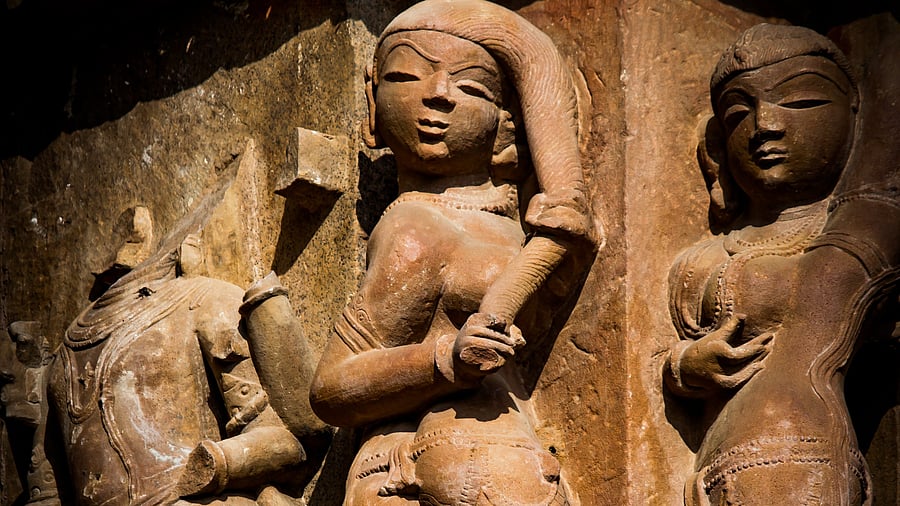
Surasundari drying her hair, Khajuraho.
Credit: Wikimedia Commons
Goddesses with weapons as hair ornaments; celestial nymphs with fashionable coiffures; the Buddha’s hair in a recognisable bun; Shiva’s matted locks — examples from art and literature present a rich history of hairdressing, which occupy a central role in aesthetic practices from the Indian subcontinent.
Evidence of this intricate art form can be found in the Indus Valley Civilisation (3300-1300 BCE). Excavations at Mohenjo-Daro and Harappa have unearthed combs made from ivory and bone, suggesting a dedicated hair care and styling practice.
Early Buddhist and Puranic literature describe elaborate procedures, including combing hair to smoothen it and applying pomade or beeswax to style it; as well as the specialised role of the king’s barber and the ritualistic cutting of his hair.
According to the Kamasutra, a text that primarily deals with the erotic, hairdressing is also one of the 64 essential kalas, or fine arts — skills that an individual has to be adept at to make themselves attractive.
The text mentions methods of shampooing and resin-smoking hair for women, so that they may add fragrance to their tresses. It also specifies that hairstyling and body hair removal are an important routine for a worldly man.
Similarly, the Natyashastra, an ancient treatise on dramaturgy by Bharata Muni, further highlights the significance of hair in performance. It gives instructions on the hairstyles to be used for the characters depicted: shaven heads for monks, curls for ‘foppish men’ and glossy hair for ‘Gandharva’ women.
In the Natyashastra, different hairstyles are also prescribed for different socio-economic classes and castes. It classifies hairstyles based on geography — curled locks for Malwa and drawn-up tufts for women from the northeast.
This tells us how hairstyles went beyond the realm of ornamentation to become an important physical marker of gender, desirability, caste, class and regional identity constructions.
This meticulous attention to hair transcends literary descriptions and finds expression in visual art. Hairstyles are visualised in paintings and sculptures from across the subcontinent.
Adorned with flowers, jewels or turbans, hair becomes a key element in the iconographic representation of royalty, attendants, dancers and, of course, religious figures and deities — such as Shiva’s recognisable jata makuta or matted crown.
Another representation of hair as an intimate marker of grace and beauty is the popular visual trope of a woman, generally dressed in a diaphanous saree or robe, combing or fixing her hair while seated in front of a mirror at her toilette. These artistic representations serve not just as decoration but as a powerful visual language.
Such visual conceptions, such as the dancer wearing her hair in a braid or a side bun, or the nayika dressing her hair in front of a mirror, continue to live on as part of modern-day costumes and choreographies of ‘classical’ dance and theatre.
The story of hairdressing in the Indian subcontinent is a testament to the enduring human desire for self-expression and beautification. It intricately connects aesthetics, social customs and religious beliefs, revealing a fascinating cultural tapestry.
Discover Indian Art is a monthly column that delves into fascinating stories on art from across the sub-continent, curated by the editors of the MAP Academy. Find them on Instagram as @map_academy